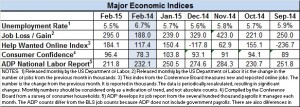Employers ignored the weather in February and defied predictions of slow hiring, instead adding 295,000 new workers to their payrolls while bringing down the unemployment rate to 5.5%.
Temp employment, however, was just the opposite.
Numbers this morning from the Bureau of Labor Statistics showed temp hiring declined by 7,800 jobs in February, while nearly all other sectors added jobs.
In addition, BLS revisions to the initial reports for January and December showed 4,000 fewer jobs were added in December than the 25,000 first reported. And for January, the BLS revised the initial loss of 4,100 jobs upwards to now say temp agencies cut 13,800 jobs.
Most other sectors added jobs, with the biggest gains coming in health (+32,800), and bars and restaurants (+58,700).
February defied economists’ predictions that brutal weather would depress hiring. They called for hiring in a range of 230,000 to 240,000 and a reduction in unemployment from January’s 5.7% to 5.6%.
The weather, however, had little effect. The construction industry continued to hire in February, adding 29,000 workers. Retailers, who had complained that record snow and cold was keeping shoppers at home, added 32,000 jobs. Auto dealers, clothing stores, specialty shops, and home improvement centers all hired workers.
Mining, a category which includes petroleum and support services, including refining, where thousands of works are on strike, shed 8,000 jobs.
 “The upside surprise should no longer be a surprise because, despite what many pessimists wish to believe, the economy is expanding at a healthy clip and creating high variety jobs again,” LandColt Capital analyst Todd Schoenberger told CNBC.
“The upside surprise should no longer be a surprise because, despite what many pessimists wish to believe, the economy is expanding at a healthy clip and creating high variety jobs again,” LandColt Capital analyst Todd Schoenberger told CNBC.
Wages, however, had little upward movement. The BLS said the increase in hourly rates was 3 cents in February, bringing the average to $24.78. That amounts to an average pay increase of 2 percent over the year, a rate of growth that hasn’t budged in the last several years. The average hourly earnings of private-sector production and nonsupervisory employees were unchanged at $20.80.
Nor did the length of the workweek change. It was 34.6 hours for employees on private nonfarm payrolls, the fifth consecutive month without a change. The average workweek for production and nonsupervisory employees on private nonfarm payrolls was unchanged at 33.8 hours.
Manufacturers, who added 8,000 jobs last month, reduced overtime by .1 hours to an average of 3.4 hours; the workweek was unchanged at an average of 41 hours.
Economists have been concerned for months about the slow wage growth. The Federal Reserve in particular has been closely monitoring pay rates as it struggles with a timetable for increasing interest rates, which are at near historic lows.
“There are perhaps hints, but we have not yet seen any significant pickup in wage growth,” Fed Chair Janet Yellen told the Senate Banking Committee last month.
Indeed.com’s chief economist, Tara Sinclair, suggested to The New York Times that the strong hiring reports this last year will put pressure on wages. “We’re at a turning point,” she said.
There are signs that may be happening. Walmart said it would raise its minimum pay to $9 an hour now, and then to $10 next year.
Moody’s Analytics chief economist Mark Zandi said during a conference call earlier this week that the recently settled port strike on the West Coast is an indication that workers are feeling the labor market is strong. He also said that the rising number of workers changing jobs is another sign of strength, and noted that when workers change jobs they average a 14 percent increase in pay.
The Dow reacted to the jobs report by shedding more than 100 points at the opening, as investors worried about the Fed’s action. The central bank will hold its policy meeting March 17-18.